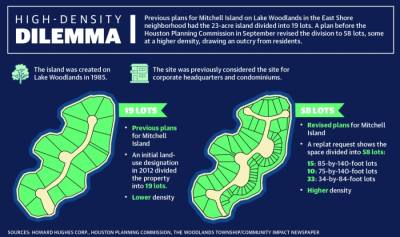Situated on Lake Woodlands, the 23-acre island is known by residents as Mitchell Island, a scenic, wooded area where eagles hunt and roost, East Shore resident Tami Houston said. She said she gathered close to 200 signatures from neighbors opposed to a Howard Hughes Corp. project on the island after she received a notice in September about a variance request there from the Houston Planning Commission, the entity that controls that process.
Gordy Bunch, the chair of The Woodlands Township board of directors, also gathered more than 1,100 signatures online for a petition to stop the 58-home development planned on the island the Howard Hughes Corp. had previously slated for 19 luxury homes. Opposition by residents in the East Shore neighborhood, which includes the island, included concern about the potential for an increase in traffic, demands on local infrastructure, threats to the habitat of the eagles seen there and other issues.“[Howard Hughes Corp.] did not consider anyone in their variance request except the people they are trying to provide a product for,” Houston said.
In a statement, Howard Hughes Corp. did not address the resident concerns specifically but confirmed the replat consists of 58 high-end residential homesites, which it said will start at $1 million in cost. The company statement said the proposal was in line with The Woodlands’ founder’s original vision for the land, although the initial land-use designation filed in 2012 was for larger lots.
“If you look at the market in East Shore, we found a lot of consumers today are moving away from large lots and oversized homes,” said Heath Melton, the executive vice president for master-planned residential communities with the Howard Hughes Corp. “The consumer wants what I would call a little bit lower-maintenance lifestyle.”
Changing plans
The Sept. 17 variance request to the Houston Planning Commission from the Howard Hughes Corp. showed a change from the initial land use designation for the property filed in 2012 that designated spaces for 19 single-family houses. The new plan showed 58 units, more than half of which would be built at a higher density on smaller lots.
Melton said the island remained when the Lake Woodlands excavation was completed in 1985.
“There was never an intent for it to remained undeveloped land,” Melton said. He said offices and condominiums were among the initially discussed possible uses for the land. The request must go before the city of Houston because The Woodlands is an unincorporated area partially within the city’s extraterritorial jurisdiction, said John Powers, the assistant general manager for community services in The Woodlands Township.
A portion of The Woodlands is located within Houston’s ETJ, and some is within the city of Conroe’s ETJ, but agreements reached among the entities in 2007 prevent either city from annexing the township until 2057.Although the replat for the site changes how the land will be divided, the variance addresses the setback of the structures, or the distance of the structure from the road. It requests a 17-foot setback for the garage and 10-foot setback for the principal structure—the standard for urban areas, according to the planning commission agenda. If the replat and variance proposal advances through the city, it has several other hurdles it still must clear, Powers said.
“The replat review and approval process is a multistep process and involves multiple agencies,” Powers said in an email among township officials, several interested residents and members of the media. “In addition to the city review, Montgomery County and [the Woodlands Township’s Development Standards Committee] must also approve.”
Powers said the DSC deals mainly with the aesthetics and size of development. The county has its own developmental permitting process as well. The property is also subject to covenants, or deed restrictions, within The Woodlands originally established by The Woodlands Community Association, DSC Chair Walt Lisiewski said.
Bunch said in an email the board of directors is not involved in the process.
Bunch gathered more than 1,200 resident signatures in September to signal local opposition to the plan in light of what they said they expected when they moved there.
“The replat request ... alters the expectations established when our residents were sold property in East Shore,” his petition states.
Bunch said the township lacks ordinance, building code or zoning authority, although 600 acres of undeveloped land remain in The Woodlands.
“The Woodlands would need to incorporate to gain authority over our hometown,” he said.
Local opposition
In addition to the hundreds of signatures garnered on petitions, about a half-dozen residents brought their concerns to the board of directors at the virtual board meeting Sept. 23.
Board Member Ann Snyder, a resident of East Shore, said in a phone interview she shares some of her neighbors’ concerns, but she emphasized the board will not have the final say.“My concerns as a resident are additional traffic, what it will do to the infrastructure of our community as we more than double the number of homes—triple—in a limited space that we as homeowners were told when we built and moved here that it was designed for 19 homes,” Snyder said.
East Shore resident Stan Hewitt told the board he was concerned about traffic because only one residential road—stemming from Timberloch Place—leads on and off of the gated island via a bridge. The road is not open to traffic, but has room for two lanes.“Obviously [the higher density] will come with triple the construction traffic, and in perpetuity, triple the residential traffic going to and from all of our homes,” he said.
Edmund “Ned” Chapman, the president of the Grogan’s Mill Village Association, elaborated on concerns about the eagles’ presence and existing protections in place in his comments to the board.
“Someone had the foresight back in 2003 to secure a federal Fish and Wildlife [Service] permit for the east side of Lake Woodlands,” Chapman said. “This provides among other things a 70-foot-wide shoreline preserve for the eagles and a requirement that 60% of the trees greater than 16 inches in diameter be protected. It is just frankly not clear how this replat can go forward without impacting our eagles.”Houston echoed the sentiment, describing her concerns about changes in the quality of life for residents of the area.
“Envision the impact of bringing the urban city to the island on the East Shore,” she said. “The traffic noise. The pounding hammers. The air you are breathing. The houses stacked like matches in a matchbook.”
Because the item was not on the board’s Sept. 23 agenda, members could not comment on residents’ concerns in depth.
The topic is expected to be on the agenda for board’s next meeting at 6 p.m. Oct. 22 at 2801 Technology Forest Blvd. The meeting is expected to be the first held in person since March and will include social distancing and other safety precautions, officials said.
Incorporation debate
During the incorporation study conducted by the township in 2019, Bunch said one reason he felt incorporation should be considered was to ensure the township’s future ability to control roads and development. Although 2020 began with the possibility of an incorporation election in November, it was dismissed by the board due to economic concerns surrounding the coronavirus pandemic.
Some residents voiced support for the idea that becoming a city could give The Woodlands additional tools to control development.
“It’s annoying and frustrating when we know that The Woodlands as a special-purpose district cannot really defend us and be out there for us,” Windsor Hills resident Ana Cosio said at the Sept. 23 meeting. “Some people may not want to be a city. But we need to put something about being a city in order to control our future, control our roads and have more of a say in what is left to be developed.”
However, Amy Lecocq, the chair of the steering committee for TownshipFuture, a political action committee in The Woodlands area, said incorporation would not be a cure all.“On the issue of whether incorporation would resolve this issue, our covenants and deed restrictions run with the land, so the resident-majority DSC has the same land-use approval authority whether we are a city or a township,” Lecocq said in an email. “This board’s incorporation plan does not include a planning and zoning department, but even if we created zoning regulations, the existing deed restrictions would still control how the land could be used.”
The board discussed having a town hall discussion on the topic in the future and inviting Howard Hughes Corp. to give a presentation, although no details were provided at the September meeting.
“We have hundreds of residents that have weighed in on the issue,” Bunch said. “I think we would have a significant, standing-room-only type environment. It may be the warranted next step.”






